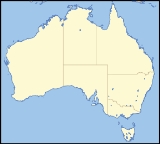
Tathra National Park
Encyclopedia
Tathra National Park is a national park
in Western Australia
(Australia
), located 240 kilometres (149 mi) north of Perth
between the towns of Eneabba
and Carnamah
on Winchester-Eneabba Road. The name is derived from a Noongar
word meaning "beautiful place".
on the slopes and hilltops, and the low heath changes in composition accordingly. The park is considered a representative sample of flora of the area, although includes some unusual plants - including a species of Daviesia
notable for its large red flowers, which is known only from the reserve, and Shaggy Dryandra (Banksia splendida
) which is common on some lateritic rises. Public usage of the park was mainly for wildflower observation in winter and spring according to a 1974 report, whose recommendation (which was not followed) would have seen it demoted to a flora and fauna conservation reserve.
National park
A national park is a reserve of natural, semi-natural, or developed land that a sovereign state declares or owns. Although individual nations designate their own national parks differently A national park is a reserve of natural, semi-natural, or developed land that a sovereign state declares or...
in Western Australia
Western Australia
Western Australia is a state of Australia, occupying the entire western third of the Australian continent. It is bounded by the Indian Ocean to the north and west, the Great Australian Bight and Indian Ocean to the south, the Northern Territory to the north-east and South Australia to the south-east...
(Australia
Australia
Australia , officially the Commonwealth of Australia, is a country in the Southern Hemisphere comprising the mainland of the Australian continent, the island of Tasmania, and numerous smaller islands in the Indian and Pacific Oceans. It is the world's sixth-largest country by total area...
), located 240 kilometres (149 mi) north of Perth
Perth, Western Australia
Perth is the capital and largest city of the Australian state of Western Australia and the fourth most populous city in Australia. The Perth metropolitan area has an estimated population of almost 1,700,000....
between the towns of Eneabba
Eneabba, Western Australia
Eneabba is a town on the Brand Highway located 278 km north of Perth, Western Australia.The area is famous for its spectacular display of wildflowers in the spring. It is also home to the Iluka Resources mineral sands facility....
and Carnamah
Carnamah, Western Australia
Carnamah is a town in the Mid West region of Western Australia, about north of Perth along the Midlands Road. According to 2006 census, the population of the town is approximately 496....
on Winchester-Eneabba Road. The name is derived from a Noongar
Noongar
The Noongar are an indigenous Australian people who live in the south-west corner of Western Australia from Geraldton on the west coast to Esperance on the south coast...
word meaning "beautiful place".
Description
The park is set in sandplain country and is surrounded by farmland, somehow having managed to escape clearing by wheat farmers in the early 20th century. Shallow valleys with sandy floors change to lateriteLaterite
Laterites are soil types rich in iron and aluminium, formed in hot and wet tropical areas. Nearly all laterites are rusty-red because of iron oxides. They develop by intensive and long-lasting weathering of the underlying parent rock...
on the slopes and hilltops, and the low heath changes in composition accordingly. The park is considered a representative sample of flora of the area, although includes some unusual plants - including a species of Daviesia
Daviesia
Daviesia is a genus of flowering plants in the family Fabaceae that are native to Australia. The genus is named in honour of Hugh Davies, a Welsh botanist.Species include:...
notable for its large red flowers, which is known only from the reserve, and Shaggy Dryandra (Banksia splendida
Banksia splendida
Banksia splendida, commonly known as Shaggy Dryandra, is a shrub endemic to Western Australia. It was known as Dryandra speciosa until 2007-Taxonomy:...
) which is common on some lateritic rises. Public usage of the park was mainly for wildflower observation in winter and spring according to a 1974 report, whose recommendation (which was not followed) would have seen it demoted to a flora and fauna conservation reserve.

